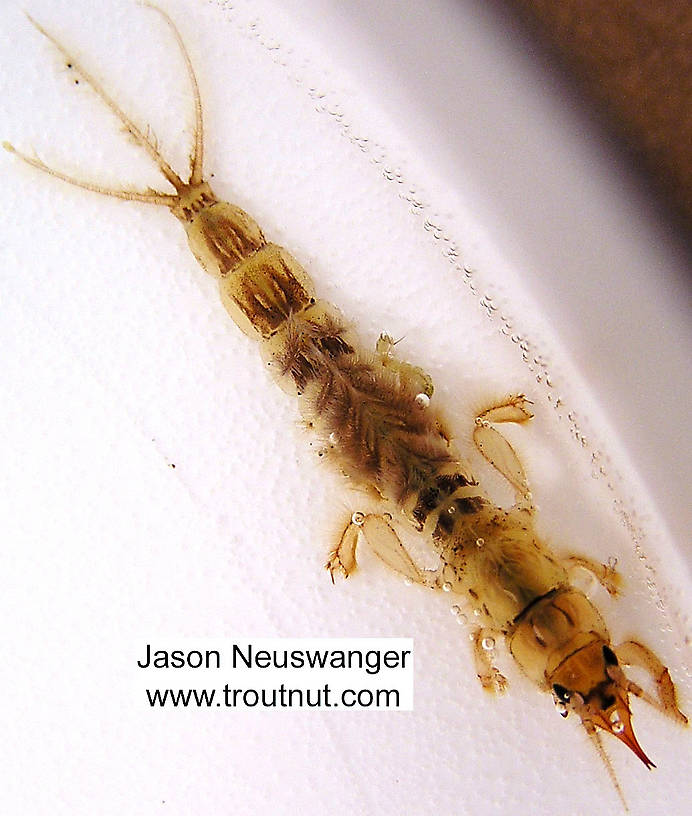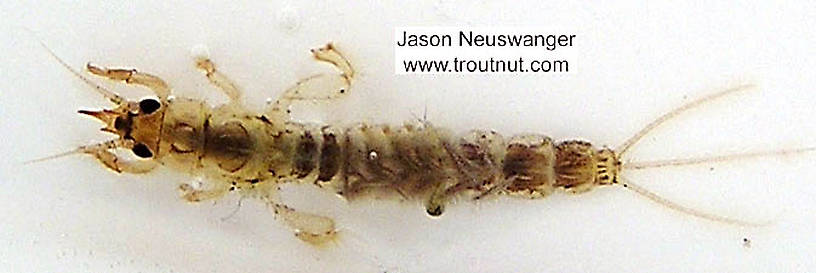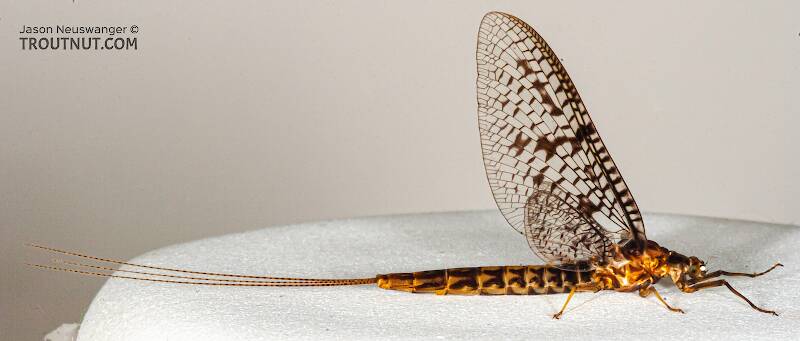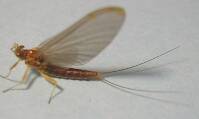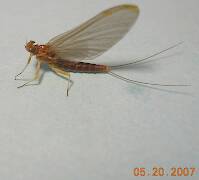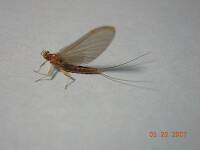
Salmonflies
Pteronarcys californica
The giant Salmonflies of the Western mountains are legendary for their proclivity to elicit consistent dry-fly action and ferocious strikes.
Featured on the forum

This one pretty clearly keys to Kogotus, but it also looks fairly different from specimens I caught in the same creek about a month later in the year. With only one species of the genus known in Washington, I'm not sure about the answer to this ID.

Troutnut is a project started in 2003 by salmonid ecologist Jason "Troutnut" Neuswanger to help anglers and
fly tyers unabashedly embrace the entomological side of the sport. Learn more about Troutnut or
support the project for an enhanced experience here.
This topic is about the Mayfly Species Ephemera simulans
The Brown Drakes are a favorite hatch of many in the Midwest, and they make a good showing on localized waters across the country. They are usually the first in a series of big drakes which bring large trout to the surface at twilight and into the early hours of the night. The experience can be much like fishing the Hexagenia limbata hatch, except that the nymphs seem to emerge from slightly more wadeable, sandy bottoms instead of the boot-sucking mud underlying the best Hex water. It will draw big trout out from the depths of a big pool to feed in the shallow tailout after dark.Example specimens
AftonAngler on Jun 5, 2006June 5th, 2006, 5:14 am EDT
Well the Brown Drakes are happening up in Bayfield, Douglas and Sawyer County streams now.
I was talking with the Queen of the Brown Drakes - Chloe Manz the other day and she was insisting that the nymphs only emerge in the late evening. I was countering that I was under the impression that they emerge in the early morning hours and sometimes during the mid day hours.
Any acurate info???
Observation on my part has subimagos around during the daylight and taking refuge in the riprian foliage until a return to the water in the very late evening (under the right conditions) as imagos for a mating flight and egg laying.
I would be interested to know if anyone has had any success fishing the emerging nymphs. I have ties up some nice, big soft hackles and am itching to give em a whirl.
By the way....there is a masking hatch up near my home stream of Sulphurs that takes a trump card over the bigger Brown Drake most evenings...last night I mistakenly switched to a Brown Drake spinner after very successfully fishing a Sulphur dun for an hour.
I could hear the fish change the sucking noises as the evening progressed into darkness and spent a unfruitfull 1/2 hour steadily working a couple of very nice fish with the brown drake spent pattern before turning my attention to the evidence...I put the headlamp on the surface and saw that the Sulphur spinners were much more predominant.
I then switched to a more appropriate spent pattern and got a bit of redemption!
Glorious evening none the less and lesson well learned!
I was talking with the Queen of the Brown Drakes - Chloe Manz the other day and she was insisting that the nymphs only emerge in the late evening. I was countering that I was under the impression that they emerge in the early morning hours and sometimes during the mid day hours.
Any acurate info???
Observation on my part has subimagos around during the daylight and taking refuge in the riprian foliage until a return to the water in the very late evening (under the right conditions) as imagos for a mating flight and egg laying.
I would be interested to know if anyone has had any success fishing the emerging nymphs. I have ties up some nice, big soft hackles and am itching to give em a whirl.
By the way....there is a masking hatch up near my home stream of Sulphurs that takes a trump card over the bigger Brown Drake most evenings...last night I mistakenly switched to a Brown Drake spinner after very successfully fishing a Sulphur dun for an hour.
I could hear the fish change the sucking noises as the evening progressed into darkness and spent a unfruitfull 1/2 hour steadily working a couple of very nice fish with the brown drake spent pattern before turning my attention to the evidence...I put the headlamp on the surface and saw that the Sulphur spinners were much more predominant.
I then switched to a more appropriate spent pattern and got a bit of redemption!
Glorious evening none the less and lesson well learned!
See you on the Water.
Brad Bohen
The Afton Angler
www.BradBohen.com
AftonAngler@BradBohen.com
Brad Bohen
The Afton Angler
www.BradBohen.com
AftonAngler@BradBohen.com
Taxon on Jun 5, 2006June 5th, 2006, 9:34 pm EDT
Brad-
The Brown Drake (Ephemera simulans) is a dusk (into darkness) emerger, except on rare occasion, like when an extreme low-light condition results from intense thunderstorm activity.
As you observed, Brown Drake subimagoes rest during daylight hours in streamside vegetation, primarily for shelter from predation and the sun, as they are absent functional mouthparts with which to replenish fluid lost through dehydration.
The Brown Drake's final metamorphosis to imago, mating swarm formation, copulation and oviposition activity are also triggered by approaching darkness, either the following evening or two evenings following emergence.
With regard to your second question, the emerging nymph actually pauses (a few inches to a foot or more) beneath the water's surface to depart its exoskeleton. It breaks through the surface film rather quickly, and floats only a short distance before taking wing. In other words, the subimago is available as trout prey for a very short period, so imitation of the emerging nymph is more likely to be productive.
The Brown Drake (Ephemera simulans) is a dusk (into darkness) emerger, except on rare occasion, like when an extreme low-light condition results from intense thunderstorm activity.
As you observed, Brown Drake subimagoes rest during daylight hours in streamside vegetation, primarily for shelter from predation and the sun, as they are absent functional mouthparts with which to replenish fluid lost through dehydration.
The Brown Drake's final metamorphosis to imago, mating swarm formation, copulation and oviposition activity are also triggered by approaching darkness, either the following evening or two evenings following emergence.
With regard to your second question, the emerging nymph actually pauses (a few inches to a foot or more) beneath the water's surface to depart its exoskeleton. It breaks through the surface film rather quickly, and floats only a short distance before taking wing. In other words, the subimago is available as trout prey for a very short period, so imitation of the emerging nymph is more likely to be productive.
AftonAngler on Jun 6, 2006June 6th, 2006, 3:27 am EDT
That is interesting...
I wonder about the survival strategy for a species like the Brown Drake - emerging at the same time that mating and egg laying takes place. There must be something to that.
I'll have to begin to watch more closely in the late evening....I can always pick out the Sulphur emergence as the subimagoes ride the surface for a good spell and it is easy for me to tell when a fish is taking a Sulphur Dun.
The Brown Drakes are far less obvious after emerging. I never see a subimago riding the surface. I suspect that the violent and splashy swirls I witness must be fish taking the nymph (an active swimmer I assume?) below the surface as it splits it's skin.
Interesting angling problem that will require some field research....
Last night we had a good thunderstorm whip in just at dusk and all but eliminated the fishing. I managed two small fish on Pass Lakes as a door prize. The fish had just started the evening rise and the winds picked up and everything just shut down like a high school kegger when the cops show up.
Tonight is another night!
I wonder about the survival strategy for a species like the Brown Drake - emerging at the same time that mating and egg laying takes place. There must be something to that.
I'll have to begin to watch more closely in the late evening....I can always pick out the Sulphur emergence as the subimagoes ride the surface for a good spell and it is easy for me to tell when a fish is taking a Sulphur Dun.
The Brown Drakes are far less obvious after emerging. I never see a subimago riding the surface. I suspect that the violent and splashy swirls I witness must be fish taking the nymph (an active swimmer I assume?) below the surface as it splits it's skin.
Interesting angling problem that will require some field research....
Last night we had a good thunderstorm whip in just at dusk and all but eliminated the fishing. I managed two small fish on Pass Lakes as a door prize. The fish had just started the evening rise and the winds picked up and everything just shut down like a high school kegger when the cops show up.
Tonight is another night!
See you on the Water.
Brad Bohen
The Afton Angler
www.BradBohen.com
AftonAngler@BradBohen.com
Brad Bohen
The Afton Angler
www.BradBohen.com
AftonAngler@BradBohen.com
Troutnut on Jun 6, 2006June 6th, 2006, 5:16 am EDT
Everything said here confirms my own experiences with the brown drakes -- when I've seen them emerge, they do it at about the same time the spinners are doing their thing. I have also seen brown drake spinners in places I had fished for consecutive evenings without seeing duns, which might mean they're emerging late at night at times.
I spent one recent day fishing the Catskills during the tail end of the green drake hatch (Ephemera guttulata) and saw some different behavior. It was a hot, bright, muggy day, and green drake duns were sporadically emerging all afternoon. Many of them rode the water for quite a long time. But that's another species...
I spent one recent day fishing the Catskills during the tail end of the green drake hatch (Ephemera guttulata) and saw some different behavior. It was a hot, bright, muggy day, and green drake duns were sporadically emerging all afternoon. Many of them rode the water for quite a long time. But that's another species...
Jason Neuswanger, Ph.D.
Troutnut and salmonid ecologist
Troutnut and salmonid ecologist
CordellManz on Jun 8, 2006June 8th, 2006, 10:40 am EDT
I would say my mom (Chloe, the brown drake queen - funnie) and "taxon" are mostly right. Most emergances take place towards evening, dusk, and into dark. I have seen and/or heard of brown drakes coming off during the day though many times. Usually cooler, cloudy days, or even in light rain. The same for the Hex hatch - it can be common for Hex's during years where we get hit with alot of colder weather in late June/early July on the Brule. I heard of a pretty good hatch of Brown drake duns on the Brule a few days ago in the morning, too. I have done very well fishing a dun pattern to the brown drake hatch also, in the evenings. That is my favorite when it is right because the fish take them harder, with louder gulping rises. They don't always ride the water long, but it can be the most effective pattern still alot of times. It is often happening at the same time the spinners are coming down, and can be overlooked I think.
lets go fishing,
Cord.
lets go fishing,
Cord.
Wiflyfisher on Jun 8, 2006June 8th, 2006, 11:10 am EDT
Dang-it, I'm mising one of my favorite mayfly hatches this year - E. simulans!!
Brad, I can tell you I have hit heavy brown drake hatches around 4:30 in the afternoon when storms have been rolling in the first part of June. I remember one June day Eric Peper and myself sitting in my car at the Seeley bridge drooling over the hordes of drakes coming off while it was raining and thundering.
Usually I find like everyone else evening is the best hatch time. I have found at times a leadwing coachmen with a grouse collar is fairly effective as an emerger. A comparadun with an extended body has worked well for me too.
John S.
Brad, I can tell you I have hit heavy brown drake hatches around 4:30 in the afternoon when storms have been rolling in the first part of June. I remember one June day Eric Peper and myself sitting in my car at the Seeley bridge drooling over the hordes of drakes coming off while it was raining and thundering.
Usually I find like everyone else evening is the best hatch time. I have found at times a leadwing coachmen with a grouse collar is fairly effective as an emerger. A comparadun with an extended body has worked well for me too.
John S.
John S.
https://WiFlyFisher.com
https://WiFlyFisher.com
Quick Reply
Related Discussions
Topic
Replies
Last Reply
I agree with the nymph and emergence coments above
In the Mayfly Species Litobrancha recurvata by Beardius
In the Mayfly Species Litobrancha recurvata by Beardius
0
Aug 1, 2008
by Beardius
by Beardius
6
Jun 10, 2009
by Martinlf
by Martinlf
5
Dec 4, 2008
by Beardius
by Beardius
6
Apr 17, 2013
by Sayfu
by Sayfu


